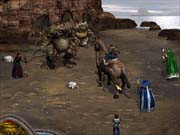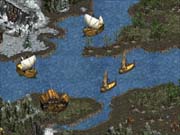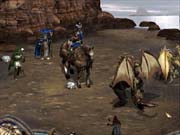Disciples II: Dark Prophecy Designer Diary #3
Producer Pro Sotos talks about fleshing out the game's scenarios, story, and background information.
Entry #3 - 02/05/01
By Pro Sotos
Producer, Strategy First
I had this really great idea about how I should start my very first designer diary. In my opinion it was not only brilliant, but it was also incredibly funny and clever. After I gave it to someone to proofread, the blank stare that person gave me was all I needed to be convinced that I'm not as funny as I think I am and that I should leave the funny stuff to the funny people and just focus on a topic.
This designer diary focuses on the scenario editor for Disciples II: Dark Prophecy. Basically a scenario editor contains code from the game. The difference is that instead of exploring a world, it lets you place all the elements that are to be found in the scenario. The scenario editor that will ship with Disciples II is the exact same one that we are using to create the scenarios you'll find in the game.
Scenario Creation

This is where the designers get to combine all the work that the programmers, artists, and the sound team have produced. Even if you've got the best looking graphics, the coolest game engine, and the finest music, if the scenario creators do a bad job, all the work that those teams have completed will go to waste. It may be a cliché, but it is true: The more time spent on creating a scenario, the better it will look and play.
From each scenario, the members of our design team demand three things: They require that (1) it's well balanced, (2) it looks good, and (3) it tells a story or follows a theme. The way the Disciples design team goes about creating scenarios is by documenting everything in a scenario. Whether it's a stand-alone quest or part of a campaign, they set down every building, resource, party, and item on paper first. I guarantee you that there are people out there rolling their eyes as they read this. They're thinking, "I don't have to waste my time by setting it all down on paper, computers let you make all kinds of adjustments instantly." While this is absolutely true, making a map seem natural takes a lot of time. By setting it out on paper, you get a better idea of what everything looks like at a glance. If time has been devoted to mapping out your scenario on paper first, it'll take you less time to get the look that you want. As a matter of fact, all of the campaigns for Disciples II were completed before the scenario editor for the game was ready. Once the editor is completely finished, designers will simply insert each one into the game.
One of the advantages to documenting everything in a scenario is that it is easier to find what items or objects have been placed into the game, and also where out of the 450 possible locations the Sword of the Ages has been placed, for example.
Story and Background

The first thing our design team members do is set a theme for each scenario. They determine the setting, races, and units that live in the area, and they create a story or purpose for the quest. The more time spent on this aspect of the game, the less time spent on trying to figure out where to place units. For instance, if the story takes place in the mountains, there probably won't be a need for sea creatures, but dwarfs and mountain dwellers will be high on the list.
When they want the quest to tell a story, they write it out first. By doing this they get a better idea of what to place in the story. This is especially true for the campaigns, since they are a series of stories that are linked together to tell a whole one. They need to know what takes place where and when.
The sooner in development the design team can identify special needs, the better the chances the other departments have to deliver them. The special requests might be for the art, sound, or programming teams--they can be easy or difficult--but the sooner the request is submitted the more likely it is to be completed.
Make it Look Good
So after they've designed all the quests, then it's an easy task for the designers to open up the scenario editor and put items into the scenario one at a time. After this, they sit back and enjoy the splendor of their creation. If you're really honest with yourself, 99 percent of the time, you're going to look at the map you've just created and say, "This looks like crap." This is when the "beauty pass" is done.
The "beauty pass" is a term developed by the Disciples team to denote the point in time of scenario creation where you make visual adjustments to the world. This is where they add the trees and other landmarks to make the world seem like a real fantasy place. The beauty pass doesn't take that long to do, but it's such an important part of scenario creation. The point of the beauty pass is not to make it look pretty. Its intent is to get the gamer to say, "Wow, that's awesome!" and not "What the hell is this?"
Is it Fun to Play
After a scenario has been designed on paper and implemented into the scenario editor, the next step is to test it. By testing, we mean that it must be played from each of the races available in the quest. If there are two races, you must make sure that both of them can win the quest at a high level of difficulty. Even though the designers lay out the quest on paper, there are so many factors that can affect the map that adjustments have to be made. For example, one of the resources may be too close or too far from a captured town, giving the race that captures it first too much of an advantage or making it not worth the effort. The play testing for balance is a lot of fun the first 20 to 30 times you play the specific scenario. After the 34th or 35th time through, it can start to get annoying. Usually it takes about two to three weeks of play testing to make sure that the map is fun to play and that it's challenging enough for all levels of difficulty.
For a campaign, the procedure is a little different because it only has to be challenging for one race. But since you have the option to carry over items and leaders from one scenario to the next, you have to be sure that the next quest is challenging enough but not impossible at different levels, with different objects. So, depending on the changes made, you might have to play only a specific quest over and over again. But if more than a few objects or parties have changed, you'll have to start the campaign from the beginning to make sure that the new items don't throw off the balance.
New Challenges

For Disciples II, the biggest question mark around play balancing involves the event system. This will allow certain events to take place at either specific times, intermittently, or however else the quest designers deem fit. For example, you capture a city that was inhabited by elves. In Disciples: Sacred Lands after you'd defeated the last elf, you were given a message telling you that you'd pay for this. This added a lot of flavor to the game and added a level of excitement. The biggest hint I would give anyone about Disciples II: Dark Prophecy is that the messages are there for a reason!
In Dark Prophecy, if the elves tell you to take heed after you kicked them out of their city, well they're probably very upset, and they'll show up to reclaim it. The effect that this has on play balancing is enormous. An event like this can add maybe a day or two to play balancing. Imagine several of them in each scenario!
Disciples Gold
Believe it or not, this is the effort that goes into each Disciples quest. It takes a long time and a lot of patience to create and test a scenario. I learned all of these things during the development of Disciples: Sacred Lands.
A few weeks ago, we started to work on Disciples Gold, which includes the bug fixes found in the patch and more than 25 new scenarios. I thought that it would be very easy for me to create several scenarios of high quality in a couple of days, after all I am the producer of Disciples. Well to make a long story short, it didn't turn out that way. So when you see it shortly on the store shelves, you'll know that each of the new scenarios made, were done with care--one at a time.
Got a news tip or want to contact us directly? Email news@gamespot.com
Join the conversation